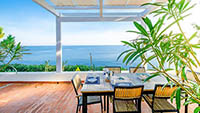Scala dei Turchi: Blue Sea and Dazzling White Rock Formations

Although the "Scala dei Turchi" means "The Turkish Staircase," you don't have to spend your holidays in Turkey to see this attraction – it is here in Sicily!
This remarkable rock formation gained its name at a time when the seafaring Turks threatened to invade Agrigento and other cities in Sicily. Popular legend has it that this was the Turks' planned gateway into the city of Agrigento.
The Scala dei Turchi is a dazzling white rocky cliff, rising 50 metres above sea level. Its gleaming colour is eye-catching enough, but what makes it all the more remarkable is that it looks like a staircase carved by man, even though its shape is entirely natural.
Author

The information on this site comes from our Sicily expert Britta Bohn.
Britta has been dealing with daily life and life in Sicily for over 20 years.
Don't miss any of her tips! Subscribe to our free Newsletter:
An Invitation
Dear friends of Sicily, we invite you to join the Facebook Group "Trip-Tipp Sicily". Find answers to all your questions and discover exclusive tips for your trip to Sicily from those who have already made the journey and those who already know the island from the inside out:
Content
- Map for a trip to the Scala dei Turchi
- Reaching Scala dei Turchi by car
- A bird's-eye view of the Scala dei Turchi
- A day out at the Scala dei Turchi
- The origins of the Scala dei Turchi
- Find your ideal holiday letting
Holidays lettings in Sicily

Are you looking for holiday lettings in Sicily but can't see the wood for the trees? We're not surprised, because the range of choices competing online is pretty confusing.
To make it simple, we present a small selection of quality holiday rentals, each one chosen for an unusual feature to make your holiday in Sicily extra special... more
Fashion made in Sicily

Sicilian fashion? Dolce & Gabbana?
Sure! But fashion designed and manufactured in Sicily is the real insider tip.
Like that of the Sicilian designer Filly Cusenza from Bagheria. She creates wearable art made of fabric, thread and buttons. Her trademark and label name is the fancy cartoon girl Filly Biz... more
The Essence of Sicily

Map for a trip to the Scala dei Turchi

- Access road
- Parking on the roadside verge
- Stairway down to the beach
- Beach
- U-turn
- Entrance
- Bar, restaurant
- Bar close to the beach
- Scala dei Turchi
- The submerged rock
Reaching Scala dei Turchi by car

The Scala dei Turchi is a few kilometers from the state road SS115, which connects Trapani in the west of Sicily with Ragusa in the east. If you are travelling from Cefalù, Palermo or other cities in the north of Sicily, the best road to use is the SS189, which connects with the SS115 just south of Agrigento.
The blue line on the map (above) marks the connection between the SS115 and the best place to park when visiting the Scala dei Turchi. This is actually a roadside verge of the Strada Provinciale 68.
To see the verge, first zoom in around marker 2 on the map. Then switch the map into "Earth" mode by clicking on the icon (bottom left). You will now see the cars parked along the green line. To reach that side of the road, you will need to do a U-turn at marker 1.
A bird's-eye view of the Scala dei Turchi

A day out at the Scala dei Turchi

The Scala dei Turchi is not only a beauty spot, but a perfect place to sunbathe and go for a swim. There is a sandy beach at the foot of the sparkling white cliffs where you can relax all day.
There is a large bar, which serves food, about half way down the road to the beach, indicated on the map by marker 3.
A great opportunity for amazing holiday photos is provided by a rock which lies just submerged, a little way out to sea from the Scala dei Turchi (marker 6). Strong swimmers can climb up onto the rocks and pose for photos which look as if they are walking on water. Be warned: do not underestimate the strength of the current and the breakers. Unless you are very confident about your swimming skills, you should just enjoy the entertainment from a safe distance.
As you can see, the Scala dei Turchi is not only a geological wonder, but also one of the most interesting beaches in the world. It tends to get quite packed in the peak holiday season. If you take your holidays in Sicily in the autumn you will be able to enjoy more space on the beach – particularly if you avoid weekends.

For those who prefer to climb up the Scala dei Turchi and enjoy the views rather than go swimming, the best time to visit would be a sunny day in winter.
If you time your trip to Sicily perfectly, you may be able to enjoy a concert on the Scala dei Turchi, like the one shown in the video to the right. After sunset, an open air concert in this setting is truly unforgettable.
The origins of the Scala dei Turchi

Once you have enjoyed wandering over the dazzling Scala dei Turchi, you may start to wonder why the rock is so white, and where the steps came from. It was entirely created by the "wanderers" – which is the meaning of the ancient Greeek word "plankton".
Many plankton are hard outside and soft inside. The hard outer case of diatoms, for example – a common variety of phytoplankton – is made of quartz. Other types of plankton have calcareous shells. When the tiny plankton die, their shells remain, and accumulate in layers.
Once enough plankton shells have been deposited, substantial mineral layers build up. If the sea evaporates, a mass extinction can occur. This is exactly what has happened in Sicily, more than once over the course of pre-history. The Mediterranean sea bed turned into nothing but a salt desert littered with plankton shells.

A fascinating film from Dallol, in northern Ethiopia (video, right) shows this same phenomenen happening today. Hot water, with various salts and minerals dissolved in it, bubbles up from the earth. With a daytime average temperature of 35°C, and a total absence of rain, this water evaporates very quickly. The remaining salts and minerals form a thick, colourful glittering layer. Even the Scala dei Turchi cannot compete with such showiness!
This is particularly true because, in Sicily, minerals have been deposited over millions of years and have eventually built a thick layer of marl, which is pure white – less colourful yet equally beautiful.
The extent of the mineral deposits is far greater than you would realise from simply looking at the amount of the Scala dei Turchi visible above sea level. The Scala dei Turchi is one of a few rare examples in which a part of the marl-rock extends into the sea, where it has been shaped by the wind and water.